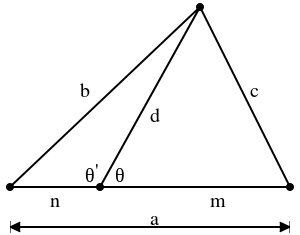Stewart's theorem
In geometry, Stewart's theorem yields a relation between a lengths of the sides of the triangle and the length of a cevian of the triangle. Its name is in honor of the Scottish mathematician Matthew Stewart who published the theorem in 1746.[1]
Theorem
Let  ,
,  , and
, and  be the lengths of the sides of a triangle. Let
be the lengths of the sides of a triangle. Let  be the length of a cevian to the side of length
be the length of a cevian to the side of length  . If the cevian divides
. If the cevian divides  into two segments of length
into two segments of length  and
and  , with
, with  adjacent to
adjacent to  and
and  adjacent to
adjacent to  , then Stewart's theorem states that
, then Stewart's theorem states that

- (This can also be written
 , a form which invites mnemonic memorization, e.g. "A man and his dad put a bomb in the sink.")
, a form which invites mnemonic memorization, e.g. "A man and his dad put a bomb in the sink.")
Apollonius' theorem is the special case where  is the length of the median.
is the length of the median.
The theorem may be written more symmetrically using signed lengths of segments, in other words the length AB is taken to be positive or negative according to whether A is to the left or right of B in some fixed orientation of the line. In this formulation, the theorem states that if A, B, and C are collinear points, and P is any point, then[2]
Proof

The theorem can be proved as an application of the law of cosines:[3]
Let θ be the angle between m and d and θ′ the angle between n and d. Then θ′ is the supplement of θ and cos θ′ = −cos θ. The law of cosines for θ and θ′ states
Multiply the first equation by n, the second equation by m, and add to eliminate cos θ, obtaining
which is the required equation.
Alternatively, the theorem can be proved by drawing a perpendicular from the vertex of the triangle to the base and using the Pythagorean theorem to write the distances b, c, and d in terms of the altitude. The left and right hand sides of the equation then reduce algebraically to the same expression.[2]
History
According to Hutton & Gregory (1843, p. 220) Dr. Matthew Stewart published the result in 1746 when he was a candidate to replace Colin Maclaurin as Professor of Mathematics at the University of Edinburgh. Coxeter & Greitzer (1967, p. 6) state that the result was probably known to Archimedes around 300 B.C.E. They go on to say (mistakenly) that the first known proof was provided by R. Simson in 1751. Hutton & Gregory (1843) state that the result is used by Dr. Simson in 1748 and by Professor Simpson in 1752, and its first appearance in Europe given by Lazare Carnot in 1803.
See also
Notes
- ↑ Stewart, Matthew (1746), Some General Theorems of Considerable Use in the Higher Parts of Mathematics, Edinburgh: Sands, Murray and Cochran "Proposition II"
- ↑ 2.0 2.1 Russell 1905, p. 3
- ↑ Proof of Stewart's Theorem at PlanetMath.org.
References
- Coxeter, H.S.M.; Greitzer, S.L. (1967), Geometry Revisited, New Mathematical Library #19, The Mathematical Association of America, ISBN 0-88385-619-0
- Hutton, C.; Gregory, O. (1843), A Course of Mathematics II, Longman, Orme & Co.
- Russell, John Wellesley (1905), "Chapter 1 §3: Stewart's Theorem", Pure Geometry, Clarendon Press, OCLC 5259132
Further reading
- I.S Amarasinghe, Solutions to the Problem 43.3: Stewart's Theorem(A New Proof for the Stewart's Theorem using Ptolemy's Theorem), Mathematical Spectrum, Vol 43(03), pp. 138 – 139, 2011.
- Ostermann, Alexander; Wanner, Gerhard (2012), Geometry by Its History, Springer, p. 112, ISBN 978-3-642-29162-3


